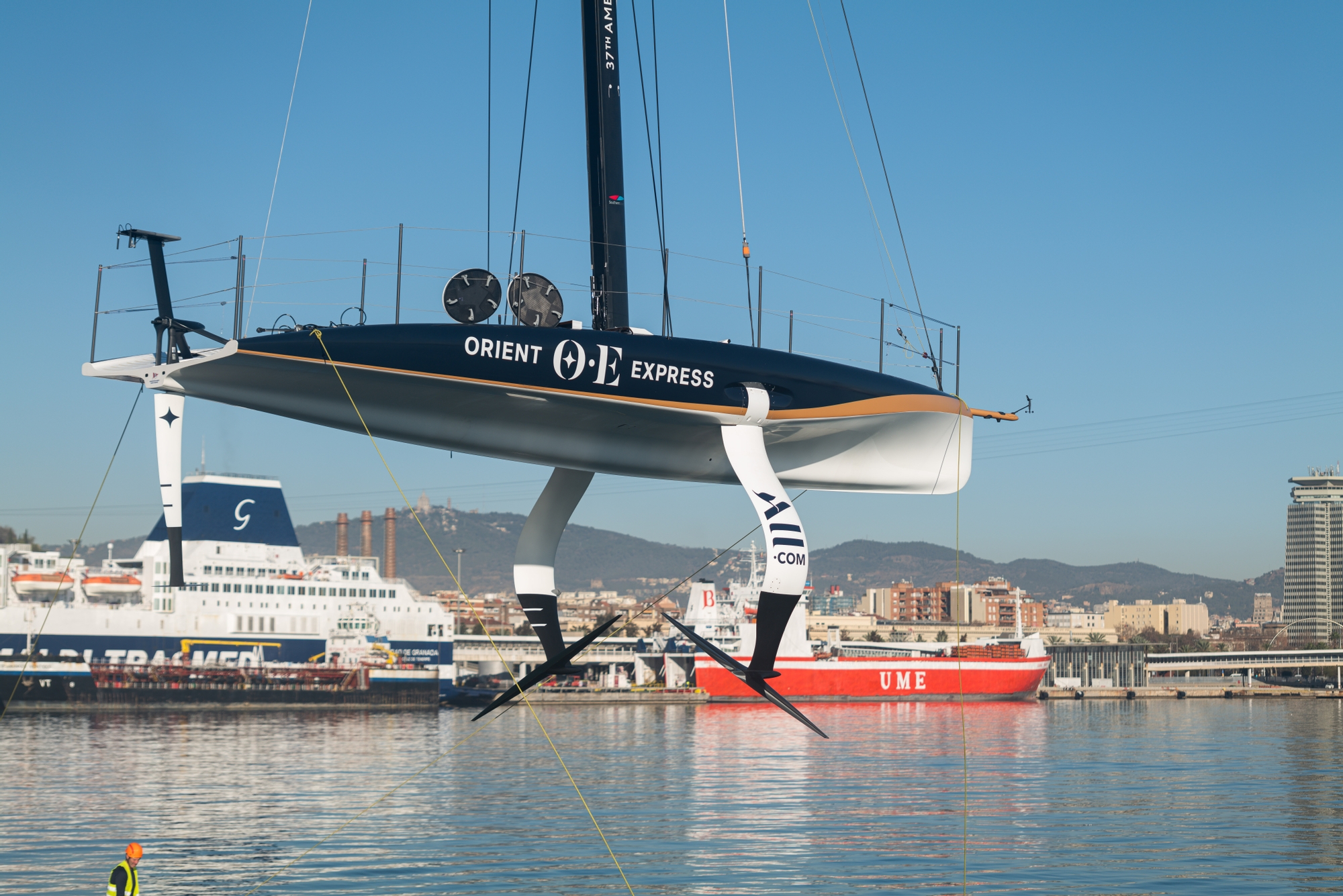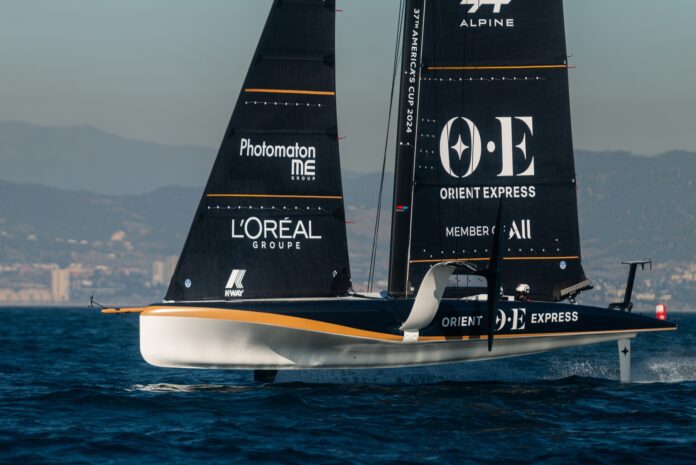Having announced a new high-performance sponsor on Friday in Alpine, part of the Renault Group, the Orient Express Racing Team came back to the water for an intense five and a half hours of full-on training, docking in at sunset and making the most of their time in manual flight control set-up.

At times ragged, this is an express train up the learning curve as the French look to close the gap on the other challengers for the 37th America’s Cup and on a classic Barcelona afternoon with a lumpy sea-state and a breeze range of 10-16 knots, they battled away at the conditions and also some boat issues relentlessly.
Taking the AC40 out of auto-pilot is akin to turning off traction control on a Renault Alpine Formula 1 car and initial attempts at bear-aways, tacks and gybes resulted in several splash downs as the crew bedded-in to their roles and responsibilities. As we’ve seen elsewhere with Cup teams in training, building in communication and accuracy are the keys to smooth and consistent flight that only time-on-the-water can yield. The French will get there – no doubt, such is the inherent talent in the team – and by the end of the session they looked increasingly assured with great flight control, windward heel and execution through the manoeuvres.

The established helm team of Quentin Delapierre and Kevin Peponnet, two great friends that have a real sailing connection on a boat, drove ever harder through the afternoon complemented by Jason Saunders and Matthieu Vandame, two experienced Flight Controllers and trimmers who are well on the way to figuring out the overall control playbook.
A great session for the French to start a big week for them and from a recon front we saw the first LEQ12 jib – a J3 – and there’s plenty more to come in the aero and systems testing through this busy period. No change on the foils and the rudder, the underwater profile was all standard one-design componentry although the recon team did note a sensor on the starboard arm – expect the tech upgrades to heat up and come onstream rapidly in the innovative French camp over the next few weeks.

Speaking afterwards, Jason Saunders came to the interview and summed up the day saying: “It was it was nice conditions out there and so we got something really good sailing in but had a few problems on the boat and had to stop multiple times to try and sort them out yeah one problem with the clue adjuster for example which was not working so a bit frustrating for all the team at times today but we also got some really good sailing out there.”

Talking about the control playbook and who does what on Flight Control and trim of the LEQ12, Jason added: “We’re just trying lots of things at the moment, and we haven’t decided how we want our playbook to work and so we’re just trying to get some hours and testing things and then we’ll figure that out at the end, we’re still a while away from making those decisions.”

And when asked about manual flight control over the merits of the auto-pilot, Jason said: “Something we’re going to analyse, we haven’t had a lot of time to come up with those conclusions yet but I think there’s some things that we can do better than the autopilot in then the auto-pilot’s also very good in some conditions and some situations so I think we can still learn a lot from the autopilot but also we may have some advantages in certain areas.”

Time is the one thing you can’t buy in the America’s Cup and the clock is ticking. The French team know they are battling the clock perhaps more than any other team but with the Emirates Team New Zealand designed AC75 in build at the Multiplast facility in Vannes, they will be eyeing development at full scale in a few months’ time. Exciting times for this most likeable of teams. (Magnus Wheatley)
On-Water Recon Report – Orient Express Racing Team: The French team took the mast out of the hangar at 8:53 a.m and at 9:05 a.m., they mount the mast on the boat. We notice a small bulb installed on the leading edge of the port arm of the boat. We believe it must be a sensor.
At 10:10 a.m. the boat is launched into the sea.
At 10:25 a.m., the OE technical team conducts some tests on the functioning of the foil arms.
At 10:57 a.m., the OE crew brings the sails to the boat and the chase boat.
At 11:05 a.m., we can see some engineers working on the screens of the Helm and Trimmer positions, and shortly after, the crew comes to make some checks.
At 12:33 p.m., they perform the dock-out, and within 5 minutes, they are already hoisting the OD M1 mainsail and the OD J3 jib.
At 12:46 p.m. they start to sail and after 500 m they stop. A technician goes onboard as it seems they have problems with the jib sheet system.
At 12:53 p.m., they start sailing upwind on starboard tack, but soon they bear-away. They have two moments of loss of control resulting in touch downs, but they continue to do some boat handling and alternate exercises of raising and lowering the leeward foil arm. They attempt two gybes with unsuccessful outcomes where they fail to get the sail through.
At 1:00 p.m., they successfully gybe and the after they started to try some boat handling sailing on different courses and alternating exercises of raising and lowering the windward foil arm.
At 1:07 p.m., they stop the boat for a moment, fixed something quickly on their own without the Chase Boat needing to come alongside. They soon continue sailing to port running downwind. They execute 2 clean gybes, and at 100 m, they stop on starboard tack. Now, the boat comes alongside, and two technicians come aboard to fix some problems again at the jib.
At 1:19 p.m., Wind 10 to 12 knots TWA 200º. The technician continues to inspect parts of the boat like the small bulb, going inside the boat through the bow hatch to check some system.
At 1:24 p.m., the technician disembarks, and they start sailing again to port.After 10 min sailing in a row they performed 5 perfect tacks, 2 ‘touch and go’ tacks and 2 touch down tacks.
At 1:38 p.m., after a short port tack they stop. Two technicians come aboard again, carrying a toolbox. It seems they are inspecting the jib mainsheet traveller. After a while, the OE Team got back to sailing, making several up winds and downwind courses, aiming for good boat handling and smooth tacks and gybes. There were some messy waves that complicated the good boat control. The wind is blowing between 12 and 14 knots with a TWD of 210.
At 2:45 p.m., they stopped and switched J3 jib to LEQ J3 jib. It took a while to start sailing with the new jib as they had some problems to raise it. With the new jib they tested boat handling and manoeuvring as well.
At 3:30 p.m., batteries need replacement, so they had to stop again for a while.
Around 3:50 p.m., they started performing bear-away exercises using the Chase Boat as a buoy. They made about 3 runs on starboard tack and 2 on port tack. From what we could see, they had quite a lot of canting angle before performing the manoeuvre so as the leeward foil tip was out of the water before bearing away.
Around 4:45 p.m., they had to stop because they seem to have problems with the mainsail and also with the jib. After a while, they decide to lower the sails and return under tow.
Due to the waves and wind, they cannot be towed while foiling, and around 6 p.m., they arrived at port.

Summary: The OE team prepared and launched the boat early in the morning, conducting tests and adjustments to the foil arms and sails. They experienced different issues with the jib along the day. Despite this, they managed to perform smooth manoeuvres, including tacks and gybes, boat handling, approaches to a mark with bear-away and foil arm in & out manoeuvres while sailing. However, they encountered further problems with the sails later in the afternoon, leading to their return to port under tow. Overall, it was a successful day of testing their skills with the manual sailing mode from the flight control systems and troubleshooting different problems from the AC40.






